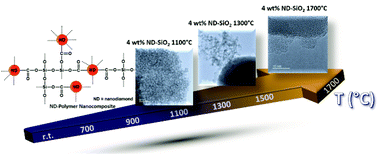Novel 0D-nanocarbon-silica ceramic composites: sol–gel synthesis and high-temperature evolution
Abstract
Herein we report the synthesis of novel 0D-nanocarbon-based silicon-containing ceramic composites by a facile salt-free synthesis method followed by polymer-to-ceramic transformation. 0D-nanocarbon–silica composites were synthesized via a one-pot sol–gel process using tetramethyl orthosilicate (TMOS) and functionalized nanodiamonds and converted subsequently via pyrolysis under an argon atmosphere into nanodiamond/silica nanocomposites. The thermal conversion of the nanodiamond phase to a multilayer fullerene phase was carefully investigated by integral and local characterization methods such as vibrational spectroscopy, X-ray diffraction, BET, SEM and HRTEM. The incorporation of nanodiamonds in a silica matrix enhances the crystallization temperature of the silica phase, as α-cristobalite, to 1500 °C, while their full graphitization is shifted to T > 1700 °C under an argon atmosphere. The thermal decomposition of the nanodiamond/silica composites leads to the formation of materials with a high specific surface area (up to 562 m2 g−1) and a mesoporous structure. No carbothermal reaction of composing phases was identified. The results obtained in the present study allow for designing advanced and highly-defined mesoporous 0D-nanocarbon-containing composites with tailored structural features and multifunctional property profiles.



 Please wait while we load your content...
Please wait while we load your content...